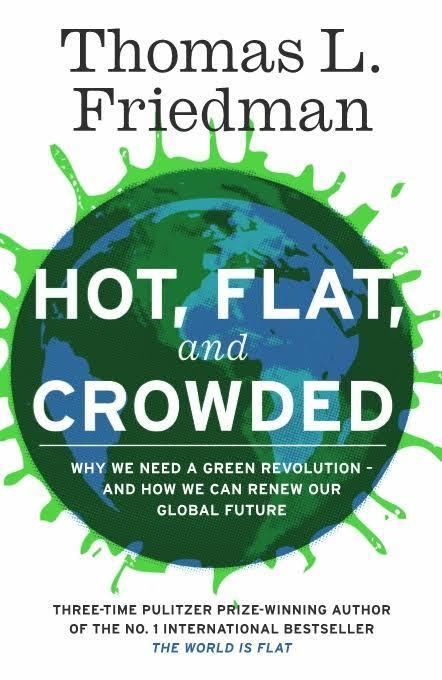7.4 /10 1 Votes7.4
Language English Media type Print, e-book ISBN 978-0312428921 Originally published 8 September 2008 Country United States of America | 3.7/5 Goodreads Publication date September 8, 2008 Pages 448 pp. Genre Non-fiction | |||||||||||||||||||||||||||||||||
 | ||||||||||||||||||||||||||||||||||
Subjects Global warming, Sustainable energy Similar Thomas L Friedman books, Climate change books, Non-fiction books | ||||||||||||||||||||||||||||||||||
Hot flat and crowded 2 0 by thomas l friedman book trailer
Hot, Flat, and Crowded: Why We Need a Green Revolution—And How It Can Renew America is a book by New York Times Foreign Affairs columnist Thomas Friedman, proposing that the solutions to global warming and the best method to regain the United States' economic and political stature in the world are to embrace the clean energy and green technology industries. The title derives from the convergence of Hot (global warming), Flat (globalization, as discussed in Friedman's book The World Is Flat) and Crowded (population growth).
Contents
- Hot flat and crowded 2 0 by thomas l friedman book trailer
- Book review hot flat and crowded by thomas friedman
- Summary
- Chapter 18 Project
- Editions
- References
The book was released on September 8, 2008, by Farrar, Straus and Giroux. The audiobook was released simultaneously by Macmillan Audio. The cover art is taken from Hieronymus Bosch's The Garden of Earthly Delights.
Release 2.0 Updated and Expanded was published in November 2009.
Book review hot flat and crowded by thomas friedman
Summary
In the book, Friedman addresses America’s surprising loss of focus and national purpose since 9/11 and the global environmental crisis. He advocates that global warming, rapidly growing populations, and the expansion of the global middle class are leading to a convergence of hot, flat, and crowded. The solution to the environmental threat and the best way for America to renew its purpose are linked: take the lead in a worldwide effort to replace wasteful, inefficient energy practices with a strategy for clean energy, energy efficiency, and conservation. This means that the big economic opportunities have shifted from IT (Information Technology) in recent decades to ET (renewable Environmental Technologies). Friedman frequently uses 2050 as a marker for when it will be too late for our world to reverse the harmful effects of climate change.
Friedman writes that the needed green revolution of the title would be more ambitious than any project so far undertaken: It will be the biggest innovation project in American history; and it will change everything from transportation to the utilities industry. This project is described in terms of nation-building.
The book alleges we've gone from the "Cold War Era" to the "Energy-Climate Era", marked by five major problems: growing demand for scarcer supplies, massive transfer of wealth to petrodictators, disruptive climate change, poor have-nots falling behind, and an accelerating loss of biodiversity. A green strategy is not simply about generating electric power, it is a new way of generating national power.
Many of the primary points of the book were built out of Friedman's New York Times Magazine essay "The Power of Green" and the "Foreign Policy" article "The First Law of Petropolitics."
Chapter 18 Project
Hot, Flat, and Crowded contains 17 chapters; Friedman has asked readers to submit ideas for the expanded edition's 18th chapter. He will use these ideas in a forthcoming expanded hardcover edition or the paperback edition. Users can submit their ideas and vote on others' ideas online.
